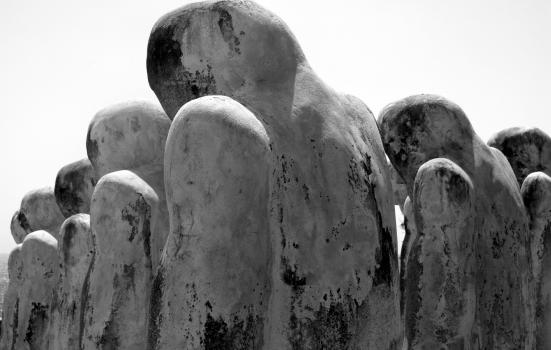The rise of the selfie has created new problems for those managing ‘dark tourism’ sites, such as Auschwitz-Birkenau. Félicie Kertudo examines how they can promote themselves ethically.

Dark tourism – travelling to places associated with any kind of destruction, disaster, death, suffering and the macabre – is a new global trend that has its roots deeply anchored in our society. Sites such as Auschwitz-Birkenau, the Killing Fields in Cambodia, Pompeii, and the 9/11 memorial are increasingly popular and famous, playing on human beings’ fascination with death and pain.
But how can arts institutions dealing with these themes balance ethics and respect with the need to reach their financial obligations? How can they use social media as a new space to promote their institution, whilst preventing reprehensible behaviour, such as half-naked selfies taken on a site of death?
Dark tourism’s growth
Dark tourism (or thanatourism) emerged as a staple in the leisure industry for a number of reasons, including globalisation and the increasing number of tourists travelling around the world; the saturation of visual images from conflicts and massacres; and the rise of an apparent national and transnational duty to remember.
Can social media be prevented from publishing people’s selfies in front of Auschwitz?
In the cultural sphere, globalisation and capitalism have brought new management practices and tools into arts and heritage organisations, like branding or franchising. Museums have had to develop a business-oriented model to remain financially viable after public funding cuts.
While the same phenomenon occurred in dark tourism institutions, it has been even trickier for them: there is a conflict between, on one hand, the need to give the illusion of not being part of the leisure economy in the name of broader philosophical concepts such as ethics, respect and memory, and, on the other hand, having to fulfil their financial obligations.
For example, the Highgate cemetery in London, where Karl Marx is buried, recently added an entrance fee in order to renovate and keep the graveyard safe, which is quite unusual for a cemetery. And, in this case, it is even more ambiguous since it is the eternal home for the so-called father of communism.
It is also important to consider the increasing access to online content, and its impact on the perception of dark tourism destinations. Recently, Shahak Shapira, a Israeli humorist based in Germany, developed the ‘Yolocaust project’, in which he overlaid selfies taken in the Holocaust Memorial in Berlin on photos taken in Nazi extermination camps during the Second World War. This project provided, among other things, a clear illustration of the long-standing controversial nature of dark tourism itself and the role played by the institutions’ management in promoting it. It is also illustrates how social media creates a new space for public discussion, allowing judgments and opinions to be shared, and heard, in contrast to bricks and mortar cultural institutions.
Managing dark tourism destinations
For numerous reasons, dark tourism destinations are more difficult than normal arts institutions to manage. There is no such thing as ‘global memory’ – even in the case of the Holocaust – and a place will have different meanings for different people, based on their own history, patrimony, and culture.
For example, I was shocked that the Holocaust Memorial Museum in Washington DC gives visitors a fake identification card of a victim of the Holocaust at the beginning of the guided tours. A teaching method to raise awareness, or a marketing tool to attract visitors? Is this not ethically questionable?
Furthermore, reprehensible behaviours cannot be easily caught and punished. For instance, can TripAdvisor be checked to ensure that people don’t write bad reviews of their experiences in memorials? Can social media be prevented from publishing people’s selfies in front of Auschwitz? Can users of dating apps Tinder and Grindr, whose profile pictures are taken half naked in the Holocaust Memorial in Berlin (sadly a true story), be banned from those applications?
These are but a few of the challenges that need to be considered by arts professionals when it comes to managing an institution that carries a sensitive and brutal history. Sensationalism and aesthetics shouldn’t be featured in those institutions. It should be the institutions’ responsibility and goal to raise visitors’ awareness.
Route forwards
Several paths forward are worth exploring for the benefit of arts managers and others involved. First and foremost, we should recognise that there can only be a global answer, combined with a greater focus on implementing cultural policies on a case-by-case basis. Indeed, the local need must also be fully accounted for.
Transnational institutions, such as UNESCO, should work closely with local governments and arts professionals, and even with the local and affected communities. Expertise, and not only from Western experts, should be brought in. A collaboration between consultants, scholars from different fields, researchers, arts managers, graphic designers, and artists could usefully find answers. A global roadmap, elaborated with all the actors listed above, would be the starting point.
The digital revolution and new technologies could also be used in certain cases, to raise global awareness of ethical issues. It is already the case at the Hiroshima Peace Memorial Park, where the local government invested in the development of a smartphone application to supply information about ‘peace tourism’ to the visitors.
The aim should be to educate visitors. Several dark tourism-related institutions have developed their own teaching methods, in response to shocking behaviours on-site and/or publicised through social media. For instance, the 9/11 Memorial built a museum to give information about the facts and meaning behind the memorial’s architecture.
More generally, school teachers and tour guides should be made aware of the weight of the past in shaping our present and future, and they should commit themselves to spreading understanding of it as much as possible.
A comprehensive and coherent policy could well succeed in turning the dark side of history into a lesson for the present and the future, for the benefit of mankind as a whole.
Félicie Kertudo is an Arts Manager based in London, and an alumni of King’s College London.
kertudo.felicie@gmail.com
@felicie_kertudo
instagram.com/felicie_k




